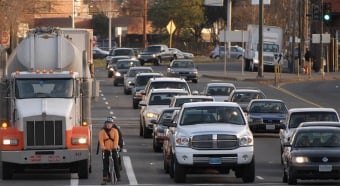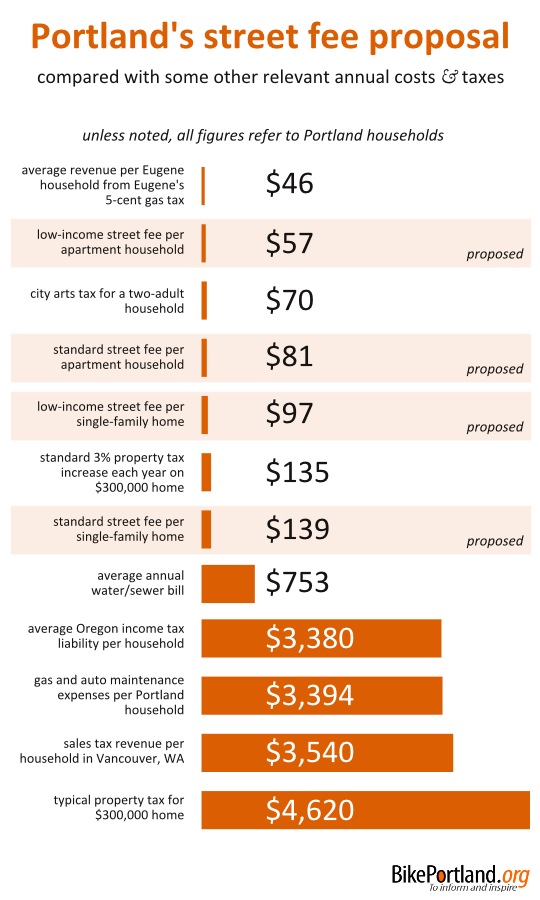
It’s a big day for the City of Portland’s push for a street fee (a.k.a. the Transportation User Fee (TUF)) as the proposed plan get its first public hearing at City Council today at 2:00 pm. In advance of that, we want to help you get caught up and primed for the discussion.
From the web to watercoolers, civic dialogue about the funding initiative is at an all-time high. That’s not just because the public hearing is imminent, but because the underlying policy continues to be tweaked and changed less than one week before Mayor Charlie Hales and Transportation Commissioner Steve Novick plan to ask their Council colleagues to vote on it. And so far, neither Hales or Novick has announced an intention to push back the fee’s effective date of July 1, 2015.
Here on BikePortland we’ve hosted a variety of perspectives about the proposed fee — with readers seeming to be split for and against the idea. Yesterday we published two guest opinions; one of them opposed to the fee and the other in support of it. (I also encourage you to read our friend Chris Smith’s opinion about the fee over on Portland Transport.)
One place we haven’t heard much from is the Bicycle Transportation Alliance (BTA). Reached today via telephone, BTA Executive Director Rob Sadowsky expressed support for the proposal, but he stopped short of a full-throated endorsement.
Advertisement
Sadowsky has been part of a special advisory committee that has been working with Novick and Hales to craft the fee proposal and he plans on testifying in support of it at City Council today. The reason the BTA hasn’t taken a major public stance is that they needed to process the ordinance details through their internal advocacy committee and reach consensus. “We only got a lot of the details last Friday,” Sadowsky said, “So, like a lot of the groups, we’re trying to figure out — does this proposal make sense? Is the pricing right? Is it balanced between residential and commercial fees?”
“In principal we’re behind it but we’re not ready to say we’re throwing full support behind it without any contingencies.”
— Rob Sadowsky, executive director of the Bicycle Transportation Alliance
Sadowsky expressed many changes the BTA would like to see to the proposal including: making sure the residential and commercial fees are voted on at the same time; that the trip generation calculation that creates the business fee is clearly defined; that there’s not a disproportionate impact on low-income households, and so on. Sadowsky also said the BTA would like the fee to be used “as a carrot to reduce trips.” “If the number of trips are helping define the price a business would pay, we’d like to find a way for people to get a lower fee if they’re actively engaged in trip reduction. For instance, if a Portland Public School has higher than 30% of kids walking and biking, they could get their fee waived.”
“In principal we’re behind it,” Sadowsky said. “But we’re not ready to say we’re throwing full support behind it without any contingencies.”
When it comes to how the new revenue would impact bicycle access in Portland, Sadowsky said the BTA feels “we come out pretty good.” According to their back-of-the-napkin math (given the current information from PBOT), the BTA calculates that about 22% of the new revenue (about $8 million per year) would have a significant and direct impact on bicycling access. That percentage comes from totaling up the expected investment in cycle tracks, crosswalk improvements, neighborhood greenways, and Safe Routes to School, Sadowsky said.
So far, unlike former Mayor Sam Adams’ approach in 2007, PBOT hasn’t touted lists of projects that the new revenue would pay for. However, the ordinance up for debate at City Council today does include a list of six specific projects that the fee would build in the first year — all of which would impact bicycling and/or walking:
Crossings/High Crash Corridors
- Rapid flash beacon crossing improvements for NE Sandy Boulevard to improve pedestrian safety
- Rumble strips on Marine Drive to prevent inattentive drivers from crossing into the other lane or crashing into the river
- Construct two new pedestrian crossings improvements on SW Beaverton-Hillsdale Highway
Safe Routes to School
- Complete the missing sidewalk network around David Douglas High School on SE 135th and SE 130th, from Stark to Division
- Safety improvements for Lents Elementary on SE 97th and Steele; traffic calming around the school boundary
- Pedestrian access to SW Portland’s Bridlemile Elementary; traffic calming along SW Hamilton from Scholl’s Ferry to Dosch
Estimates for how much the fee would raise per year range from $30-$50 million. Right now, PBOT is asking standard households to pay about $139 per year. We were curious how that stacked up to other fees — and how it differed from the other proposed fees in the plan — so we created this infographic to help compare (note that business fees aren’t included since Council is likely to delay them):

(Gas and auto maintenance figures: Commissioner Steve Novick. Vancouver sales tax figures: Washington Department of Revenue. Eugene gas tax: City of Eugene estimate, 2011. Oregon income tax figures: Oregon Department of Revenue. Portland property tax estimate assumes a $22 per $1,000 millage rate, which is around average for Portland, and a 70 percent taxable value ratio, the current countywide average for single-family homes.)
(Graphic: BikePortland)
With so much riding on the future of this fee, we’re watching it closely. Stay tuned for more coverage and thanks for all your contributions to the discussions thus far. For more on the proposal see the official website at OurStreetsPDX.com and read our past coverage here.


